Menus
- Honda CB 1100 F, Kawasaki Z 1000 J, Suzuki GSX 1100 Katana
- Suzuki Katana: design icon
- Kawasaki: comfort athlete
- Honda: strong and timeless
- Honda CB 1100 F.
- Kawasaki Z 1000 J.
- Suzuki GSX 1100 Katana
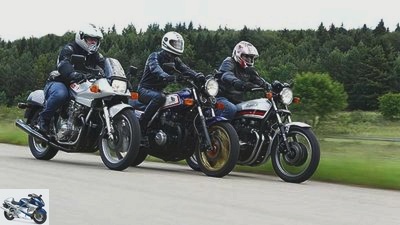
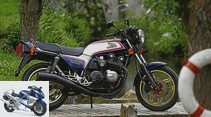
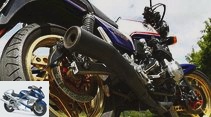
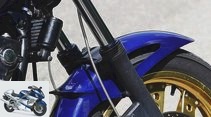
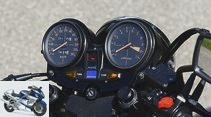
21st photos
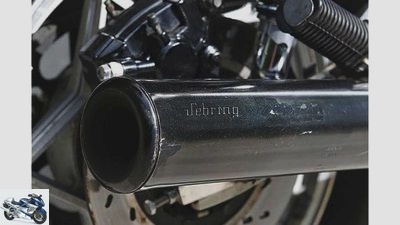
1/21
Suzuki GSX 1100 S.
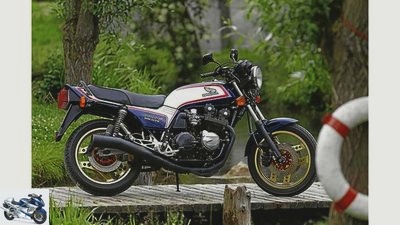
2/21
Honda CB 1100 F: Technology Compared to the successful 900 series, the uncovered top model of the Bol d’Or series not only has 160 cubic centimeters more, but also a modified chassis. Honda achieved the increase in displacement to 1062 cm³ with larger pistons, now 70 instead of 64.5 millimeters. The Super Bol dOr practically took over the inner workings of the sporty flagship, the CB 1100 R..
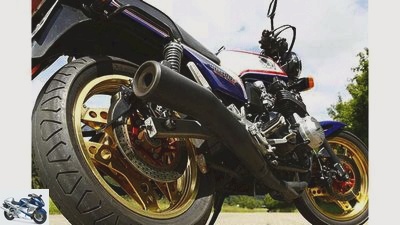
3/21
Honda CB 1100 F – In demand: the powerful and perfectly fitting four-in-one exhaust from Eckert.
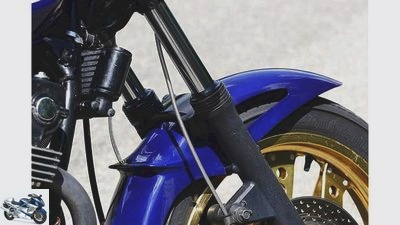
4/21
Honda CB 1100 F – hood for the hunt: A small spoiler directs the airstream to the oil cooler.
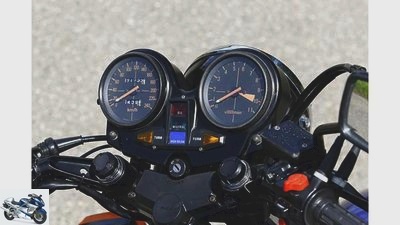
5/21
Honda CB 1100 F: perfectly legible instruments.
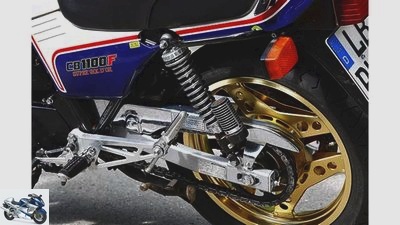
6/21
Honda CB 1100 F.
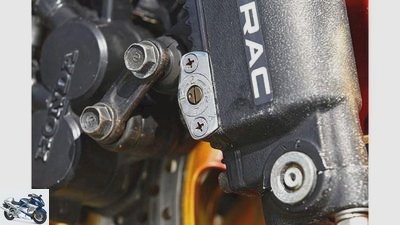
7/21
Honda CB 1100 F.
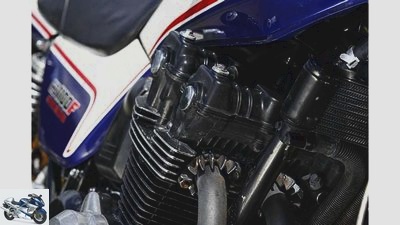
8/21
Honda CB 1100 F.
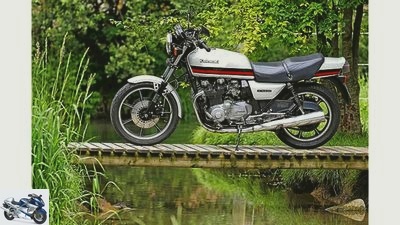
9/21
Kawasaki Z 1000 J: While competitors in the 1981 race for the athlete’s crown had long relied on four-valve technology, Kawasaki sent the Z 1000 J with a two-valve engine into the race, which with its roller-bearing crankshaft premiered in 1972 in the legendary Z1. Constantly facelifted, the Z 1000 J could easily keep up with the more modern designs, at least in terms of top performance, but it was a bit of a problem when it came to pulling through.
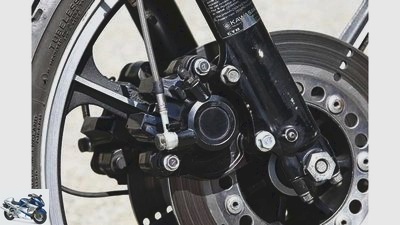
10/21
Kawasaki Z 1000 J: Bite-proof front double pane.
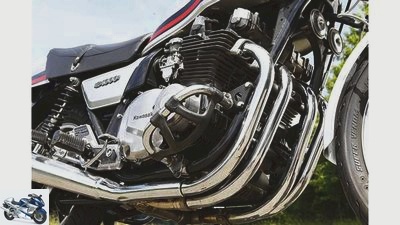
11/21
Kawasaki Z 1000 J: The last evolutionary stage of the Z1 two-valve engine.
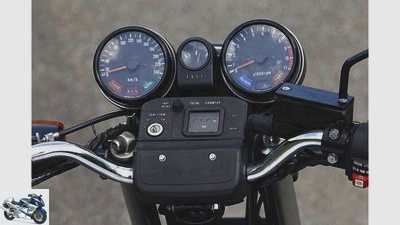
12/21
Kawasaki Z 1000 J: The instruments are jagged but easy to read.
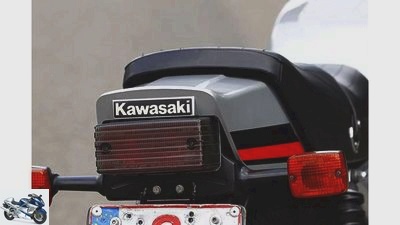
13/21
Kawasaki Z 1000 J – Black Seer: Chasers look at a black taillight.

14/21
Kawasaki Z 1000 J.
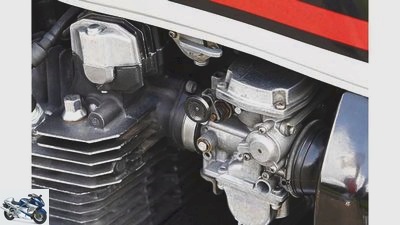
15/21
Kawasaki Z 1000 J.
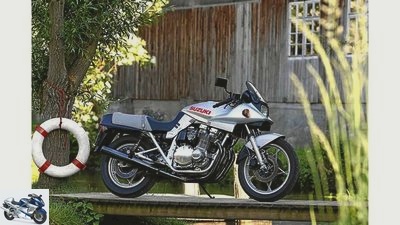
16/21
Suzuki GSX 1100 Katana: Take the engine and chassis from the GSX 1100, put the characteristic Katana line on top – is the designer piece finished? No, it wasn’t that easy for Suzuki in 1981 with its top model Katana. Otherwise the production of the production bike would probably not have taken 15 months. With the beefy 1.1-liter four-cylinder, however, the engineers could actually limit themselves to fine-tuning. The four-valve engine that was presented just two years earlier was still considered the benchmark in the big bike class. The revision of the roller-bearing crankshaft was enough to improve the smoothness and performance. However, the katana styling required major changes to the chassis.
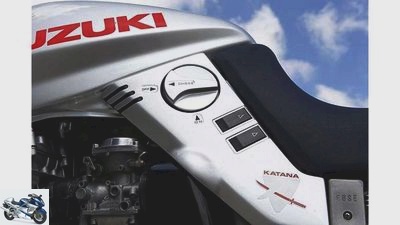
17/21
Suzuki GSX 1100 Katana: knob as choke.
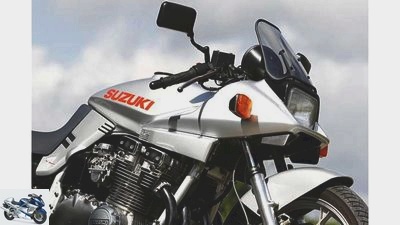
18/21
Suzuki GSX 1100 Katana: The tank fits seamlessly into the crouched fairing.
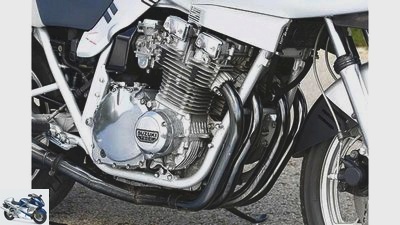
19/21
Suzuki GSX 1100 Katana: Within the big bike trio, the four-valve engine swings the most powerful torque club.
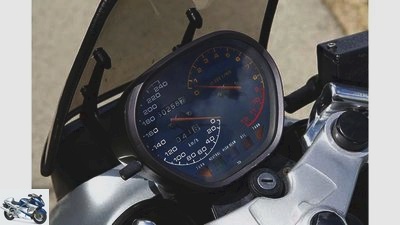
20/21
Suzuki GSX 1100 Katana: The instrument cluster irritates with opposing displays.
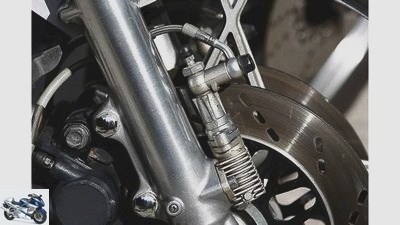
21/21
Suzuki GSX 1100 S.
On the move: classic big bikes
Honda CB 1100 F, Kawasaki Z 1000 J, Suzuki GSX 1100 Katana
Content of
Do you really have to travel to the Himalayas and climb an 8000 meter to experience the peak of emotions? No. In the early 80s, the Japanese 1000s or 1100s were enough for us. And you got on it at the motorcycle dealer around the corner.
He’s a phantom. Almost everyone knows him, but nobody has seen him yet. He can strike anywhere and anytime. That makes him so unpredictable, the mean defect devil. Today he has Harald on his back. Or rather: his Honda CB 1100 F. First a weak battery made for sweaty sliding starts, then a kinked fuel hose for an involuntary interruption. And now the Honda is on the side of the road with an acute attack of weakness. A cylinder has hiccups, rattles in vain for the high-octane elixir of life – carburettor tight, the classic. In the third attempt, he made it, the avenger of all negligence: For the super-Bolle it’s shift.
The day had started so well. Punctually at nine o’clock the Honda, a Kawasaki Z 1000 J and Suzuki’s extravagant are ready GSX 1100 Katana in the glaring sunlight, ready for a curve dance over the Swabian Alb together. What a wonderful sight, even hiking lovers of nature pause for a moment before being touched. And what a wonderful view: I can actually give the heroes of my youth the spurs today. It is the superstars of the early 80s when the Olympic motto dated in Japan "faster Higher Further" Especially in large-volume, air-cooled four-cylinders, it was compressed into such ignitable mixtures that the sales figures for motorcycles virtually exploded.
These power bikes were the ultimate back then, but remained – not only – an unattainable dream for me. That is exactly why they are burned into the memories of many motorcycle freaks like the fly shit in the cooling fins. Here we go. The mighty four-cylinder engines wake up with a dull babble. I run three or four times for each of the displacement cars, and I can hardly wait. And I’m secretly happy that these aren’t early retired showpieces from the living rooms of meticulous collectors. It’s about bikes that are still in the middle of life.
Sure, almost three decades and mileage of 50,000 (Suzuki), 71,000 (Honda) and 78,000 kilometers (Kawasaki) have left their mark on them. But not every rockfall, every scratch, every little renovation tells the story of an eventful life? "My" Trio stands by it, presents itself completely without make-up. Good thing, because a few scars do not take away any of their still impressive charisma.
Suzuki Katana: design icon
Suzuki GSX 1100 Katana: The driver sits more in a sporty way than on the Suzuki.
This is especially true for Martin’s 1100 katana. What a hot potato that was! Its design polarized so violently in 1981 that success literally stood on the knife’s edge. Love or hate, there was nothing in between. That has long since changed, today the katanas, especially the 1100s, are among the few design icons from the Far East. Martin fell for the allure of the extraordinary at an early age, and ten years ago he fulfilled his childhood dream. Since then he has been a catanic skin and hair type, as two other copies in the garage and the tattoo on his right upper arm prove. With the exception of Konis, steel braided brake lines and a contemporary Sebring four-in-one exhaust system, Martin’s 1100 is in its original condition.
To celebrate the day, he even bought her a brand new bench from his spare parts pool. I feel well integrated into the motorcycle in the recess, but I have to stretch quite a bit towards the aluminum stubs. Comfort is different, especially since the knee angle is also tight, although the notches are attached far back on the pillion arms. It takes a few kilometers, but then I got used to the athletic posture. It puts a lot of weight on the front wheel and gives you the feeling of perfect control.
It’s amazing how swiftly the Suzuki swings through the curves of the Lautertal. The heavy chunk reacts to a slight pull on the handlebars, willingly tilts and, at least at country road speed, refrains from any hint of nervousness. No wonder that the Katana chassis was once so praised, even at top speed on the autobahn, the testers were pretty enthusiastic back then. It’s reassuring to know. Today, however, I’m in no hurry, I’m moving within the framework of the law. Admittedly, that’s difficult. Because the rough Suzuki propellant reacts to the slightest twitch of the right hand with violent forward thrust, even in fifth gear at 50 km / h. An extremely confident drive, as if made for enjoyable power cruising.
I am not interested in the fact that the four-valve engine can also do other things, turning quickly into the red area if necessary. I let myself drift, listen to the robust roar of the Sebring system and enjoy how stress-free you can have fun with these old cars – because you don’t have to prove anything to yourself or to others. If you don’t see it in such a relaxed way, always pulling the cable all the way and looking for the kick in the last groove, you shouldn’t be surprised if you are quickly shown the limits. Be it in the form of blunt brakes, wobbling undercarriages or components that touch down early. But let’s be honest: do you really want to destroy your childhood dream in such a disdainful way? Just.
Kawasaki: comfort athlete
Kawasaki Z 1000 J: The Kawa’s two-valve engine does well.
So I don’t really care that the Kawasaki Z 1000 J shows noticeably less vigor in direct comparison with the Katana below. The last evolutionary stage of the classic Kawasaki four-cylinder engine, ignited in 1981, is still based on the Z1 two-valve engine with roller bearings. And he was almost ten years old at the time. For Peter, a part-time capo of the Z-Club Germany and hostess of a whole fleet of Z-models, reason enough to expand the collection. After all, the Z 1000 J is the last classic one-liter variant with chain drive and carburettors. Peter picked up the silver piece of jewelry three years ago in Holland.
Steel braided brake lines and cones were already there, but not the pillion passenger retaining bracket. The only serious shortcoming, because without this linkage jacking up with the main stand becomes a feat. I only notice that Kawasaki saw the Z 1000 J as a particularly sporty one-liter machine from its top performance characteristics and the amazingly snappy brakes, and also from the almost playful ease with which it zaps through alternating curves.
Otherwise, it is more of their excellent all-round properties that the 1000s ingratiate themselves with in everyday life. The long bench offers both driver and passenger plenty of space and an extremely comfortable seating position. There are also comfortable spring elements, a large tank and clearly laid out instruments. The smooth throttle response is also great. In the long run, the only really annoying are the too soft and underdamped fork as well as the strong vibrations of the engine at medium speeds, which the partial rubber mounting does not correct.
Love it, or leave it – these expressions of life simply belong to the rough fellow. If at some point we only roam the area on electric bikes, we will definitely long for it.
Honda: strong and timeless
Honda CB 1100 F: The timeless design of the Honda has no expiration date.
Right now, however, I just long for a working Honda. It’s just frustrating when you meet a mature lady for a brisk (curve) dance – and she just has standing blues on it. After all: the Super-Bol-d´Or is still an attractive appearance. Its harmoniously curved lines, which extend from the tank to the rear end, give it a timeless elegance. Only: I don’t have time. But it should take two more days before the Honda can rehabilitate itself with freshly cleaned carburettors. As soon as you sit on it shows why it is called "Super" in the name: It impresses with perfect ergonomics and operation as well as a successful seating position. Also convincing: the easy to dose brakes. And finally the four-cylinder, which is well in the forage again.
Vibrations? Not an issue thanks to rubber mounts. Force? Always and everywhere, although the Suzuki pushes harder below. Sound? But hello! What escapes the four-in-one from tuner Roland Eckert makes the walls shake. The Bolle, on the other hand, does not behave shakily at all, at least during a moderate gallop on country roads. Despite the soft fork, it maintains a precise course, although it seems more stubborn than the Kawasaki in alternating curves. When challenged, she can really fool her pilot, I know that from before. Do I try again? The autobahn is close. I think about it for a moment, but immediately discard the plan. What is such a stupid stress test, the territory of these cars is the country road. Also, based on my recent experience, I would have a few concerns about challenging the Honda. What if the devil doesn’t just ride me? After all, it is known to be in the detail. Even if he’s never been seen.
Honda CB 1100 F.
Harald Axmann and the Honda CB 1100 F.
The CB 1100 belongs to a friend. I myself have been driving a 900 Bol d’Or for 30 years. That’s why I know these models are very reliable. The 1100 has noticeably more steam and looks very confident. You can’t quite say the same about the chassis. The timeless design is great.
Kawasaki Z 1000 J.
Peter Krauss and the Kawasaki Z 1000 J.
The Z-Virus grabbed me for a long time. I usually like the classic variants. But the J is the last and technically best 1000 of the series. That’s why it just belongs in my collection. It offers the best all-round properties and reliability for little money.
Suzuki GSX 1100 Katana
Martin Wessels and the Suzuki GSX 1100 Katana.
The big katana was my childhood dream. The design is simply awesome, as is the powerful engine. For her age, she can also be moved pretty quickly. Of course, I also like the fact that it is so rare today in its original condition. I’m not giving away my 1100 katana anymore.
Related articles
-
Air-cooled big bikes Kawasaki GPZ 1100 UT, Laverda RGS 1000 and Suzuki GSX 1100 EF
fact 48 pictures fact 1/48 The engines are the stars, they still exude charm and, in the case of GPZ, RGS and GSX, clearly inspire …
-
factstudio.de 29 photos fact 1/29 One against all. Ducati SuperSport S in comparison test with Suzuki GSX-S 1000 F, Kawasaki Z 1000 SX, Honda VFR 800 F…
-
Jahn comparison test of supersports: Ducati 998, Honda Fireblade, Kawasaki ZX-9R, Suzuki GSX-R 1000, Triumph Daytona 955i Centennial The K-Question Five …
-
fact Concept comparison Honda CBR 1100 XX Kawasaki ZX-12 R Suzuki GSX-R 1000 Suzuki GSX 1400 Yamaha FZS 1000 Fazer Yamaha FJR 1300 Six bombs The six …
-
BMW F 800 GT against Honda CBF 1000 and Suzuki GSX 650 F
Bilski 18 pictures Bilski 1/18 The three all-rounders: Honda CBF 100 F, BMW F 800 GT and Suzuki GSX 650 F in a comparison test. Bilski 2/18 Sporty …
-
Honda Hornet 600, Kawasaki Z 750, Suzuki GSR 600, Yamaha FZ6
Jahn Honda Hornet 600, Kawasaki Z 750, Suzuki GSR 600, Yamaha FZ6 Comparison test all-rounder Do you do a job in a high position? as the darling of the…
-
Comparison test touring enduro bikes: Honda Transalp, Kawasaki Versys, Suzuki V-Strom 650
Jahn comparison test travel enduro: Honda Transalp, Kawasaki Versys, Suzuki V-Strom 650 Always on the wall, travel enduro does not necessarily mean BMW …
-
Gargolov comparison test big bikes: Honda CBR 1100 XX Super Blackbird, Kawasaki Ninja ZX-12R, Suzuki GSX 1300 R Hayabusa, Yamaha FJR 1300 A Two fast, Two …
-
On the move: Honda VF 1000 R, Kawasaki GP Z 900 R, Suzuki GSX-R 1100
Jahn On the move: Honda VF 1000 R, Kawasaki GP Z 900 R, Suzuki GSX-R 1100 Technical revolution Content of They drove us crazy – and saved us money:…
-
Suzuki GSX-S 1000 Katana, GSX-S 1000 & GSX 1100 S Katana in comparison
tysonjopson.com, Rossen Gagolov, Achim Steinmacher 20th photos tysonjopson.com, Rossen Gagolov, Achim Steinmacher 1/20 The new edition of the…